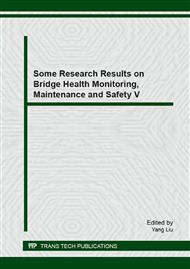[1]
D.M. Frangopol & M. Liu. Maintenance and Management of Civil Infrastructure based on Condition, Safety, Optimization, and Life-Cycle Cost. Structure and Infrastructure Engineering, 3(1): 29-41. (2007).
DOI: 10.1080/15732470500253164
Google Scholar
[2]
F.N. Catbas, M. Susoy & D.M. Frangopol. Structural health monitoring and reliability estimation: long span truss bridge application with environmental monitoring data. Engineering Structures, 30: 2347-2359. (2008).
DOI: 10.1016/j.engstruct.2008.01.013
Google Scholar
[3]
Q. Qin. Health monitoring of long-span bridges. China Journal of Highway and Transport, 13(2): 37-42. (2000) (in Chinese).
Google Scholar
[4]
A.Q. Li & C.Q. Miu. Health monitoring system for the Runyang Yangtse River Bridge. Journal of Southeast University, 33(5): 544-548. (2003). (in Chinese).
Google Scholar
[5]
D.M. Frangopol, A. Strauss, and S. Kim. Use of monitoring extreme data for the performance prediction of structures: General approach. Engineering Structures, 30: 3644-3653. (2008).
DOI: 10.1016/j.engstruct.2008.06.010
Google Scholar
[6]
A. Strauss, D.M. Frangopol, and S. Kim. Use of monitoring extreme data for the performance prediction of structures: Bayesian Updating. Engineering Structures, 30: 3654-3666. (2008).
DOI: 10.1016/j.engstruct.2008.06.009
Google Scholar
[7]
J.R. Casas. Reliability-based assessment of masonry arch bridges. Construction and Building Materials, 25: 1621–1631. (2011).
DOI: 10.1016/j.conbuildmat.2010.10.011
Google Scholar
[8]
X.P. Fan & D.G. Lu. Real-time reliability forecast of bridge structures based on multiple bayesian dynamic linear models. Journal of South China University of Technology, 41(3): 67-72. (2013) (in Chinese).
Google Scholar
[9]
M. West, J. Harrison. Bayesian forecasting and dynamic models (Second Edition). Springer series in statistics. (1997).
Google Scholar
[10]
G. Petris, S. Petrone, P. Campagnoli. Dynamic linear models with R. New York: Springer series. (2009).
Google Scholar
[11]
H.N. Mahmoud, R.J. Connor, C.A. Bowman. Results of the fatigue evaluation and field monitoring of the I-39 Northbound Bridge over the Wisconsin River. ATLSS report no. 05-04, Bethlehem (PA, USA): Lehigh University. (2005).
Google Scholar
[12]
D.F. Li. Reliability Updating and Detection Maintenance Decision-Making of Concrete Bridge Members. Dissertation for the Master Degree in Engineering, Harbin Institute of Technology. (2008).
Google Scholar
[13]
A. H. -S. Ang, W.H. Tang. Probability concepts in engineering planning and design, vol. II. Wiley, New York. (1984).
Google Scholar
[14]
X.P. Fan, D.G. Lu. Reliability prediction of bridges based on monitored data and Bayesian dynamic models. Key Engineering Materials, 574: 77-84. (2014).
DOI: 10.4028/www.scientific.net/kem.574.77
Google Scholar


